Books by Mihai S Rusu
Presa Universitară Clujeană, 2024
Pandemia de COVID-19 și măsurile implementate de autoritățile publice pentru limitarea răspândiri... more Pandemia de COVID-19 și măsurile implementate de autoritățile publice pentru limitarea răspândirii virusului – care au inclus ample campanii de vaccinare a populației, carantină (lockdown), purtarea obligatorie a măștilor și interzicerea manifestărilor publice și private și alte politici, printre altele – au bulversat în mod substanțial toate componentele societății. De la restricții stricte asupra mobilității individuale până la suspendarea funcționării unor întregi sectoare ale sistemului sociale (educație, cultură, muncă), oamenii și societățile s-au văzut puși în situația excepțională de se adapta unei urgențe de sănătate publică la nivel global, cu consecințe disruptive fără precedent.

Editura ULBS, 2023
Denumirile de străzi, plăcile memoriale și monumentele publice sunt „locuri ale memoriei” care de... more Denumirile de străzi, plăcile memoriale și monumentele publice sunt „locuri ale memoriei” care definesc o geografie politică a comemorării. Cine sunt personalitățile, evenimentele istorice și valorile politice după care sunt botezate străzile și care sunt figurile alese pentru a fi imortalizate în piatră sau bronz reflectă modul în care o comunitate alege să își cultive propriul trecut. Cartea de față examinează dintr-o perspectivă interdisciplinară etosul ideologic reflectat în artefactele materiale (busturi, statui, monumente) și nominale (nomenclatorul urban) care alcătuiesc peisajul memorial al Sibiului. Situată la intersecția dintre istoria politică, geografia culturală si sociologia memoriei, lucrarea îmbină analizele documentare cu cele statistice pentru a evidenția, în perspectivă istorică, politicile memoriei așa cum a fost aceasta spațializată într-un „oraș memorial” precum este Sibiul.

Editura Institutul European, 2022
Volumul explorează politicile spațiului simbolic implementate în perioada care a urmat prăbușirii... more Volumul explorează politicile spațiului simbolic implementate în perioada care a urmat prăbușirii regimului comunist în România. Denumirile de străzi, plăcile memoriale și statuile amplasate în spațiul public constituie piesele de bază ale ordinii topo-memoriale a unui regim politic. Aceasta deoarece valorile politice, miturile istorice și simbolurile identitare sunt materializate în astfel de artefacte culturale. Tocmai de aceea, în contextul tranziției de totalitarism la democrație, în fostele țări socialiste din Europa Centrală și de Est, nomenclatoarele stradale și monumentele au făcut obiectul unor masive intervenții din partea autorităților postcomuniste, în efortul de a elimina simbolurile fostului regim din spațiul public. În cartografierea transformărilor suferite de peisajele memoriale în România postsocialistă, o atenție specială este acordată atitudinilor sociale față de redenumirea străzilor și înlăturarea monumentelor publice care erau asociate cu fostul regim. Lucrarea este elaborată pe baza unei anchete sociologice realizate pe un eșantion de peste o mie o sută de respondenți. Datele astfel obținute ne permit să înțelegem modul în care indivizii obișnuiți se raportează față de aceste schimbări, variațiile atitudinale între regiuni și generații, precum și să surprindem factorii care le modelează.

Editura Institutul European, 2020
Bârfa ocupă un loc privilegiat în structura vieții sociale. Oamenii bârfesc în practic orice împr... more Bârfa ocupă un loc privilegiat în structura vieții sociale. Oamenii bârfesc în practic orice împrejurări și circumstanțe, pentru a schimba informații valoroase despre cunoscuți, pentru a-și exprima indignarea morală față de faptele reprobabile ale apropiaților sau, pur și simplu, ca delectare conversațională. Totodată, bârfirea este pe atât de condamnată de pe pozițiile moralizatoare ale teologiei și filosofiei pe cât este de practicată ca activitate socială specifică traiului de zi cu zi. În ciuda acestui fapt, subiectul nu a fost abordat cu seriozitate analitică în științele sociale. Cartea de față își propune să schimbe acest lucru, evidențiind importanța deținută de acest act comunicațional aparent banal – bârfirea aproapelui absent – în cadrul mai larg al relațiilor interpersonale și realității sociale. Lucrarea analizează bârfirea ca practică centrală a vieții cotidiene și arată că, atunci când este motivată de intenții pozitive precum curiozitatea socială, strădania de a afla adevărul și dorința de a împărtăși informații, bârfa contribuie substanțial la configurarea și menținerea ordinii socio-morale. Fără a ignora fațetele ignobile ale bârfei (calomnie, ponegrire, denigrare), cartea pledează pentru reconsiderarea bârfirii dintr-un păcat al limbii într-o practică socială intrinsecă traiului în comun.

Lucrarea abordeaza, intr-o maniera simultan comprehensiv-holistica si detaliat-analitica, fenomen... more Lucrarea abordeaza, intr-o maniera simultan comprehensiv-holistica si detaliat-analitica, fenomenul memoriei istorice romanesti, asezat de autor in centrul nervos al identitatii nationale. Interogand fenomenul pe care si-l fixeaza ca obiect de cercetare de pe pozitii social-constructioniste, abordarea analitica propusa de Mihai Stelian Rusu reuseste sa surprinda, desfasurate in durata lunga a ultimelor doua secole de existenta istorica romaneasca sub zodia ideii nationale, diferitele ipostaze sub care s-a alcatuit memoria istorica elaborata pentru a tine treaz trecutul romanesc in constiinta colectiva. Alaturi de ideea nationala, luata drept axa centrala a identitatii romanesti si vectorul memoriei istorice, educatia scolara este acreditata nu doar ca principala agentie de nationalizare identitara, ci si ca o cruciala institutie culturala a memoriei nationale. Fara exceptie relativ la regimul politic in care a fost organizata exercitarea puterii de stat, scoala a fost insarcinata ideologic cu misiunea de a socializa populatia in narativa dominanta despre trecut favorizata de status quo-ul politic. Ca atare, cartea scruteaza tripticul relational configurat intre identitate-memorie-educatie, aratand, pe de o parte, cum identitatea este dependenta de memoria istorica si cum, pe de alta parte, atat identitatea, cat si memoria utilizeaza educatia ca institutie sociala pusa in slujba socializarii populatiei in acest 'complex identitar-mnemonic' in care rezida constiinta istorica de sine a unei colectivitati.
Journal Articles by Mihai S Rusu

Women's Studies International Forum, 2024
The gendered patterning of urban street names as part of the spatial production of broader male-c... more The gendered patterning of urban street names as part of the spatial production of broader male-centric memorial landscapes has been documented in a growing body of scholarship. Scholars from various cognate fields, such as cultural geography, gender and memory studies, and urban sociology, have unraveled the stark gender disparities favoring men inscribed into symbolic landscapes through place names, public monuments, and other memorial artefacts. This article sets out to overcome some of the limitations characterizing this strand of researchnamely, the lack of statistical sophistication and the preference for case studies based on singular citiesby developing a multi-level modelling of gendered street nomenclature at the national level. The approach developed in this paper employs the complete collection of urban street names in Romania to assess the empirical adequacy of five hypotheses regarding the gendered structuring of the country's urban namescape. This analysis highlights the factors underpinning the variation of gender disparities in terms of Romania's historical regions, ethnic demographics and local ethnopolitics, city ranking within the national territorial administration and intraurban stratification of the road network, as well as the effects brought about by postsocialist transformations.

Journal of Romanian Studies, 2024
Besides being canonized as Romania's "national poet," Mihai Eminescu was hailed as the "complete ... more Besides being canonized as Romania's "national poet," Mihai Eminescu was hailed as the "complete man of Romanian culture" and the "absolute Romanian," among a profusion of encomiastic praises. Eminescu was immortalized in myriads of ways, from the most solemn and official (e.g. state-run rituals) to the most prosaic and banal (e.g. banknotes). In this article, I investigate the spatial dimension of Eminescu's memory by charting the commemorative landscape defined by toponymy and public monuments honoring the national poet in Romania. Particular attention is given to Eminescu's presence in urban street nomenclature and its regional distribution across the country. Drawing on several datasets of spatial information, I use statistical modeling techniques to examine the factors underpinning Eminescu's memorial namescape. Employing logistic regression analyses, the article highlights an uneven geography of Eminescu's memory and points out the variables structuring its particular spatial patterning.

Annals of the American Association of Geographers, 2024
Political geographers and sociologists working in the field of critical toponymies have demonstra... more Political geographers and sociologists working in the field of critical toponymies have demonstrated that renaming the streetscape follows invariably after a regime change. Scholars have barely gone beyond documenting the extent of toponymic change at the level of particular places, however, usually the capital cities of countries from the former socialist bloc and other postdictatorial societies. This article sets out to address toponymic changes at the country level, by examining the complete national street nomenclature in postsocialist urban Romania. For this purpose, a data set comprising the entire collection of urban street names in Romania, together with all the street name changes that occurred during postsocialism, was constructed from multiple sources (N = 37,076). A series of multilevel logistic regression analyses were performed to model statistically the effects of various street- and locality-level variables on postsocialist street renaming. The results of these multilevel logistic regression analyses indicate that toponymic revision after the fall of state socialism is shaped by the intersection of street-level properties (e.g., artery class and features regarding the street name itself) and locality-level characteristics (e.g., the historicity of urban status and the ethnopolitics played out at the level of each city and town). The article is the first to analyze the shifting political geography of urban nomenclatures at a national level based on a complete data set of street names. The analytical model advanced in this article, based on postsocialist Romania, could be used to inform similar research on other geographical settings and historical contexts.
批判性地名领域的政治地理学家和社会学家已经证明, 政权更迭之后总是伴随着街景的更名。然而, 学者们仅仅记载了特定地方的地名变化, 常常包括前社会主义集团和其它后独裁社会的首都。本文旨在研究后社会主义罗马尼亚全国城市街道的命名, 来探讨国家层面的地名变化。本文构建了多源数据集, 包括罗马尼亚所有城市的街道名称、后社会主义期间的所有街道名称变化(N = 37,076)。进行了一系列多层逻辑回归分析, 对街道尺度和地方尺度变量影响后社会主义街道更名进行了统计建模。多层逻辑回归分析结果表明, 国家社会主义垮台后的地名修正, 是由街道特性(例如, 与街道名称有关的干线类别和特征)和地方特征(例如, 城市的历史性和城镇的民族政治)共同塑造的。本文首次基于完整的街道名称数据集, 分析了国家尺度城市命名政治地理的变化。本文提出的基于后社会主义罗马尼亚的分析模型, 可用于其它地理环境和历史背景的类似研究。
Los geógrafos políticos y los sociólogos que trabajan en el campo de las toponimias críticas han demostrado invariablemente después del cambio de régimen se cambian los nombres del paisaje de las calles. No obstante, los eruditos a duras penas han ido más allá de establecer la extensión del cambio toponímico al nivel de lugares particulares, usualmente las ciudades capitales de los países que hicieron parte del bloque socialista, y de otras sociedades posdictatoriales. Este artículo se orienta a abocar los cambios toponímicos a nivel de país, examinando la completa nomenclatura nacional de calles en la Rumania urbana postsocialista. Para tal fin, se elaboró un conjunto de datos derivados de múltiples fuentes (N = 37.076), que comprende la colección completa de nombres de calles en la Rumania urbana, junto con todos los cambios de nombre de las calles ocurridos durante la era postsocialista. Se realizó una serie de análisis de regresión logística multinivel para modelar estadísticamente los efectos de diversas variables, a nivel de calle y localidad, sobre el cambio postsocialista de la nomenclatura de calles. Los resultados de estos análisis de regresión logística multinivel indican que la revisión toponímica tras la caída del socialismo de estado está configurada por la intersección de las propiedades a nivel de calle (e.g., la clase de arteria vial y los rasgos propios del nombre de la calle en sí mismos) y las características a nivel de localidad (e.g., la historicidad del estatus urbano y la etnopolítica jugada a nivel de cada ciudad y poblado). El artículo es el primero en analizar la cambiante geografía política de las nomenclaturas urbanas, a un nivel nacional, con base en un conjunto de datos completo de nombres de calles. El modelo analítico que se propone en este artículo, basado en la Rumania postsocialista, podría usarse para informar investigaciones similares sobre otros escenarios geográficos y contextos históricos.
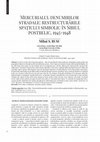
Transilvania, 2022
In order to achieve their functional purpose – that of organizing the urban landscape and helping... more In order to achieve their functional purpose – that of organizing the urban landscape and helping locating people and geographical objectives through an efficient addressing system – street names are bound to remain stable spatial landmarks. On the other hand, street names are also semiotic devices of signifying space with the political and commemorative agenda of the ruling power. This latter characteristic renders them vulnerable to successive renaming following important power-shifts and especially regime changes. What happens when the ideological imperative of politicizing the street nomenclature undermines its functional requirement of providing spatial orientation through extensive renaming? Such a tensional situation is examined in the case of postwar Sibiu between 1945 and 1948, when the city endured a thorough redefinition of its toponymy under the political regime of communist “popular democracy” in Romania. The paper quantifies the scope of toponymic revision and then evaluates the content of these street name changes in terms of three major concepts: class, ethnicity, and gender. Grounded on the results of this analysis, the paper advances the notion of “mercurial street names”. It concludes by arguing that such a concept should complement the existing metaphoricity underpinning the scholarship in place-name studies, which draw on “text”, “discourse”, and “palimpsest” to conceive of the processes of street (re)naming.

Names: A Journal of Onomastics, 2022
The gender relations of power embedded within the urban landscape and materialized in street nome... more The gender relations of power embedded within the urban landscape and materialized in street nomenclature remain an underexplored topic in place-name studies. This paper situates the gendered spaces of street names within the broader investigation of identity politics played out in the public space. Drawing on scholarship from "critical toponymies", this article diachronically examines the gender patterning of urban nomenclature in a city from Eastern Europe (Sibiu, formerly Hermannstadt, Romania). For this purpose, a dataset was compiled from the entire street nomenclature of the city across seven successive historical periods, from 1875 to 2020 (n = 2,766). The statistical analyses performed on this dataset revealed a "masculine default" as a structuring principle underpinning Sibiu's urban namescape for the two centuries investigated. As this analysis demonstrates, contrary to the overall democratization of the Romanian post-socialist society, Sibiu's streetscape continues to tell a patriarchal story informed by hegemonic masculinity.
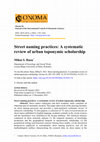
Onoma: Journal of the International Council of Onomastic Sciences, 2021
Street names (odonyms) and their academic study constitute an important part of onomastic researc... more Street names (odonyms) and their academic study constitute an important part of onomastic research. This paper takes stock of the growing literature on street naming processes and provides a meta-analytical systematic review of odonymic scholarship. To this purpose, a collection of 121 peer-reviewed articles on street names published in English language academic journals in the social sciences and the humanities were identified in the Scopus database. The statistical analyses conducted on these materials indicate (1) the temporal dynamics of knowledge production and the geographical hotspots in toponomastic scholarship, (2) the geopolitical settings and historical contexts framing these studies, (3) the theoretical perspectives employed to conceptualise street naming practices, and (4) the methodological outlines characterising the research done on street names in the literature. The conclusions point out four main clusters of toponomastic research and indicate directions for future inquiry in street name scholarship.
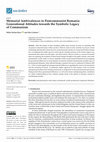
Societies, 2021
After the demise of state socialism, public space became an issue of contention that occupied an ... more After the demise of state socialism, public space became an issue of contention that occupied an important place within societies’ efforts to come to terms with the recent past. Extant scholarship documented extensively how postcommunist societies in Central and Eastern Europe have reconfigured the public space by removing the symbolic presence of the former regime (e.g., monuments and statues, but also place- and street names). However, there is a scarcity of research done on exploring the reception of these broad changes brought to the public statuary and urban nomenclature. In this study, we aim to contribute to this nascent strand of literature by investigating the generational differences in social attitudes towards the symbolic transformation of public space in postcommunist Romania. Data collected through a national web-survey conducted in February 2021 (n = 1156) revealed significant intergenerational differences regarding the removal of monuments and the renaming of streets. In particular, higher approval of such memory work was found among the generations born during communism in comparison to the postcommunist generation. Taking stock of these generational differences, as well as the factors underpinning them, contributes to a better understanding of how ordinary people relate to the politics of memory enacted in transforming societies.

Southeast European and Black Sea Studies, 2020
Private cemeteries constitute a new development in the Romanian postsocialist death system that p... more Private cemeteries constitute a new development in the Romanian postsocialist death system that poses a challenge to the traditional burial culture. This paper charts the emergence of privately owned, profit-oriented cemeteries that have appeared across the country after the demise of state socialism. It argues that the development of these new, entrepreneurial burial grounds is to be understood at the intersection of several factors: (1) transformations in the country’s political economy after the overthrow of the socialist regime have facilitated the diffusion of an entrepreneurial ethos in the realm of death and body disposal. Against this background, (2) a burial crisis produced by overcrowded cemeteries was mounting, which (3) the local state authorities largely failed to address. Using empirical data collected from multiple sources, the paper examines statistically the private cemeteries opened in Romania’s postsocialist deathscape as well as the burial crisis affecting the public cemeteries, which stimulated the former’s development. Lastly, the paper takes stock of the Romanian Orthodox Church’s reaction to this trend and charts its shifting position from the initial vehement condemnation of private cemeteries to market accommodation after the adoption of the 2014 law regulating the burial grounds.
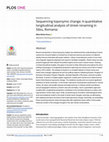
PloS ONE, 2021
Recent scholarship in critical toponymy studies has refashioned the understanding of street names... more Recent scholarship in critical toponymy studies has refashioned the understanding of street names from innocent labels to nominal loci of historical memory and vectors of collective identity that are embroiled with power relations. Urban nomenclatures consist of more than mere linguistic signposts deployed onto space to facilitate navigation. Street names are also powerful signposts that indicate the political regime and its socio-cultural values. Drawing on these theoretical insights, this paper is focused on Sibiu (Romania) and explore the city’s shifting namescape in a longitudinal perspective spanning one century and a half of modern history (1875–2020). The analysis is based on a complete dataset of street names and street name changes registered across five political regimes (Habsburg Empire, Kingdom of Romania, Romanian People’s Republic, Socialist Republic of Romania, and post-socialist Romania). A series of multiple logistic regression models were carried out to determine the factors that influence toponymic change. The statistical results point out several significant predictors of street renaming: (1) the streets’ toponymic characteristics (politicized or neutral name); (2) artery rank (public squares and large avenues or ordinary streets and alleys); and (3) topographic features (a street’s size and centrality). Such a quantitative approach coupled with a longitudinal perspective contributes to the scholarly literature on place-naming practices in three major ways: firstly, by advancing an innovative methodological framework and analytical model for the study of street name changes; secondly, by delineating with statistical precision the factors that model toponymic change; and thirdly, by embedding these renaming practices observed especially after significant power shifts in the broader historical context of the changes brought in the city’s street nomenclature.

Extant scholarship on football stadium names is almost exclusively restricted to discussing namin... more Extant scholarship on football stadium names is almost exclusively restricted to discussing naming rights deals as expressions of toponymic commodification. Departing from this rather strict focus, this paper sets out to examine the patterns of stadium names from a quantitative perspective that is based on a dataset comprising football stadiums from around the world (n=1485). Drawing on this empirical material, the paper conducts a multinomial logistic regression analysis focused on determining the factors that influence a stadium’s name as: (a) being neutral (names carrying generic, local and/or descriptive connotations); (b) being political (names celebrating ideological values, historical dates and/or political personalities); (c) representing sports figures (names commemorating sportspersons, either former players or club officials); and (d) representing sponsorship (corporate names). The model points out that variations in stadium names are accounted for mostly by the football continental confederation, but are also influenced by a stadium’s features such as capacity, year of construction and the status of being a shared venue or designated as the national stadium.

Cuadernos de Historia Contemporánea, 2020
This paper aims at discerning the models of fascist femininity endorsed by the Romanian National ... more This paper aims at discerning the models of fascist femininity endorsed by the Romanian National Legionary State. It consists in a quantitative content analysis performed on articles published in the regime's official newspaper, Cuvântul, in a permanent column addressed to women. The findings point out the prevalence of the traditional model of "domestic womanhood" over the masculinized model of "warrior femalehood." This quantitative approach grounded on content analysis is complemented by a qualitative approach based on a visual analysis of women's depiction in the Legion's printed press. Visual commercials, product advertising featuring women and other depictions of female figures reveal a third, heterodox, type of womanhood that we suggest calling "Legionary chic." Based on these findings, the study concludes by pointing out the heterogeneity of the National Legionary State's politics of womanhood.
[es] Feminidades fascistas: modelos de mujer en el Estado Nacional Legionario de Rumanía Resumen. Este artículo tiene como objetivo examinar los modelos de feminidad fascista respaldados por el Estado Legionario Nacional rumano. Consiste en un análisis cuantitativo de contenido realizado sobre artículos publicados en el periódico oficial del régimen, Cuvântul, en una columna permanente dirigida a las mujeres. Los resultados señalan la prevalencia del modelo tradicional de "feminidad doméstica" sobre el modelo masculinizado de "feminidad guerrera". Este enfoque cuantitativo basado en el análisis de contenido se complementa con un enfoque cualitativo basado en un análisis visual de la representación de las mujeres en la prensa impresa de la Legión. Los anuncios visuales, la publicidad de productos con mujeres y otras representaciones de figuras femeninas revelan un tercer tipo de feminidad heterodoxa que sugerimos llamar "Chic legionaria". Con base en estos hallazgos, el estudio concluye señalando la heterogeneidad de la política de feminidad del Estado Nacional Legionario. Palabras clave: roles de género; fascismo femenino; Mujer Nueva; política de la feminidad; Guardia de Hierro rumana.
Sumario. 1. Introduction. 2. The "green" press and the National Legionary State. 3. Methodological underpinnings. 4. Models of Legionary womanhood 5. "Legionary chic" as a heterodox model of fascist femininity. 6. Conclusions: The multiplicity of Legionary womanhoods.

Social Change Review, 2021
As toponymic means of inscribing urban space, street names have been addressed mainly by human ge... more As toponymic means of inscribing urban space, street names have been addressed mainly by human geographers, who have articulated the field of critical place-name studies. In this paper, I continue the endeavor started in the previous issue published in Social Change Review of reading street names through sociological lenses. Whereas in the first part of this two-part contribution the analysis was made from functionalist and conflictualist perspectives, this second and final part employs social constructionism and the utilitarian theoretical tradition in making sociological sense of street nomenclatures. First, conceiving of street names as forming discursively constructed linguistic landscapes, the paper shows how urban namescapes – the “city-text” – are written, erased, and rewritten to reflect the shifting political powers. Second, the paper examines the neoliberal processes of place branding and toponymic commodification by which street names are turned into sought-after urban commodities with transactional value on the real estate market. The paper concludes by inviting sociologists to join the conversation on street names, which should become an important topic of sociological reflection.
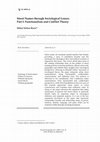
Social Change Review, 2020
Street names are mundane spatial markers that besides providing a sense of orientation inscribe o... more Street names are mundane spatial markers that besides providing a sense of orientation inscribe onto the landscape the ideological ethos and political symbols of hegemonic discourses. This review article takes stock of the existing scholarship done on the politics of street naming practices in human (political, cultural, and social) geography and rethinks these insights from sociological perspectives. Drawing on Randall Collins’ taxonomy of sociological theory, the paper interprets urban street nomenclatures along functionalist, conflictualist, constructionist, and utilitarian lines. The analysis is delivered in two installments: Part I addresses urban nomenclatures from functionalist and conflictualist perspectives, while Part II (published in the next issue of this journal) approaches street names as social constructions and examines their utilitarian value. In doing so, the paper advances the argument that urban namescapes in general and street names in particular should make an important object of sociological reflection and empirical analysis. It is one of the key arguments developed in this paper that toponymy encapsulates broader and intersecting issues of power, memory, identity, language, and space which can be rendered visible through sociological analysis.

Southeast European and Black Sea Studies, 2020
Private cemeteries constitute a new development in the Romanian postsocialist death system that p... more Private cemeteries constitute a new development in the Romanian postsocialist death system that poses a challenge to the traditional burial culture. This paper charts the emergence of privately owned, profit-oriented cemeteries that have appeared across the country after the demise of state socialism. It argues that the development of these new, entrepreneurial burial grounds is to be understood at the intersection of several factors: (1) transformations in the country’s political economy after the overthrow of the socialist regime have facilitated the diffusion of an entrepreneurial ethos in the realm of death and body disposal. Against this background, (2) a burial crisis produced by overcrowded cemeteries was mounting, which (3) the local state authorities largely failed to address. Using empirical data collected from multiple sources, the paper examines statistically the private cemeteries opened in Romania’s postsocialist deathscape as well as the burial crisis affecting the public cemeteries, which stimulated the former’s development. Lastly, the paper takes stock of the Romanian Orthodox Church’s reaction to this trend and charts its shifting position from the initial vehement condemnation of private cemeteries to market accommodation after the adoption of the 2014 law regulating the burial grounds.

Nationalities Papers: The Journal of Nationalism and Ethnicity, 2020
The cult of death and the celebration of martyrdom lay at the core of interwar fascist movements ... more The cult of death and the celebration of martyrdom lay at the core of interwar fascist movements across the European continent. However, it was in the Romanian Legionary Movement (also known as the Iron Guard) that these were articulated into a full-fledged ideology of thanatic ultranationalism. In this article, I examine the spectacular fascist necropolitics staged as state-sponsored funeral performances during the short-lived National Legionary State (September 14, 1940–February 14, 1941). A detailed description of the massive campaign of exhumations and reburials of the so-called “legionary martyrs” carried out during this short time span, culminating with the grandiose ceremony organized for the reburial of Corneliu Zelea Codreanu on November 30, 1940, provides insight into the legionary thanatic worldview and ritual praxis. It also sheds light on the movement’s politics of commemoration, death, and afterlife and shows how these were embedded into a religious framework underpinned by theological concepts such as heroic martyrdom, vicarious atonement, and collective redemption.









Uploads
Books by Mihai S Rusu
Journal Articles by Mihai S Rusu
批判性地名领域的政治地理学家和社会学家已经证明, 政权更迭之后总是伴随着街景的更名。然而, 学者们仅仅记载了特定地方的地名变化, 常常包括前社会主义集团和其它后独裁社会的首都。本文旨在研究后社会主义罗马尼亚全国城市街道的命名, 来探讨国家层面的地名变化。本文构建了多源数据集, 包括罗马尼亚所有城市的街道名称、后社会主义期间的所有街道名称变化(N = 37,076)。进行了一系列多层逻辑回归分析, 对街道尺度和地方尺度变量影响后社会主义街道更名进行了统计建模。多层逻辑回归分析结果表明, 国家社会主义垮台后的地名修正, 是由街道特性(例如, 与街道名称有关的干线类别和特征)和地方特征(例如, 城市的历史性和城镇的民族政治)共同塑造的。本文首次基于完整的街道名称数据集, 分析了国家尺度城市命名政治地理的变化。本文提出的基于后社会主义罗马尼亚的分析模型, 可用于其它地理环境和历史背景的类似研究。
Los geógrafos políticos y los sociólogos que trabajan en el campo de las toponimias críticas han demostrado invariablemente después del cambio de régimen se cambian los nombres del paisaje de las calles. No obstante, los eruditos a duras penas han ido más allá de establecer la extensión del cambio toponímico al nivel de lugares particulares, usualmente las ciudades capitales de los países que hicieron parte del bloque socialista, y de otras sociedades posdictatoriales. Este artículo se orienta a abocar los cambios toponímicos a nivel de país, examinando la completa nomenclatura nacional de calles en la Rumania urbana postsocialista. Para tal fin, se elaboró un conjunto de datos derivados de múltiples fuentes (N = 37.076), que comprende la colección completa de nombres de calles en la Rumania urbana, junto con todos los cambios de nombre de las calles ocurridos durante la era postsocialista. Se realizó una serie de análisis de regresión logística multinivel para modelar estadísticamente los efectos de diversas variables, a nivel de calle y localidad, sobre el cambio postsocialista de la nomenclatura de calles. Los resultados de estos análisis de regresión logística multinivel indican que la revisión toponímica tras la caída del socialismo de estado está configurada por la intersección de las propiedades a nivel de calle (e.g., la clase de arteria vial y los rasgos propios del nombre de la calle en sí mismos) y las características a nivel de localidad (e.g., la historicidad del estatus urbano y la etnopolítica jugada a nivel de cada ciudad y poblado). El artículo es el primero en analizar la cambiante geografía política de las nomenclaturas urbanas, a un nivel nacional, con base en un conjunto de datos completo de nombres de calles. El modelo analítico que se propone en este artículo, basado en la Rumania postsocialista, podría usarse para informar investigaciones similares sobre otros escenarios geográficos y contextos históricos.
[es] Feminidades fascistas: modelos de mujer en el Estado Nacional Legionario de Rumanía Resumen. Este artículo tiene como objetivo examinar los modelos de feminidad fascista respaldados por el Estado Legionario Nacional rumano. Consiste en un análisis cuantitativo de contenido realizado sobre artículos publicados en el periódico oficial del régimen, Cuvântul, en una columna permanente dirigida a las mujeres. Los resultados señalan la prevalencia del modelo tradicional de "feminidad doméstica" sobre el modelo masculinizado de "feminidad guerrera". Este enfoque cuantitativo basado en el análisis de contenido se complementa con un enfoque cualitativo basado en un análisis visual de la representación de las mujeres en la prensa impresa de la Legión. Los anuncios visuales, la publicidad de productos con mujeres y otras representaciones de figuras femeninas revelan un tercer tipo de feminidad heterodoxa que sugerimos llamar "Chic legionaria". Con base en estos hallazgos, el estudio concluye señalando la heterogeneidad de la política de feminidad del Estado Nacional Legionario. Palabras clave: roles de género; fascismo femenino; Mujer Nueva; política de la feminidad; Guardia de Hierro rumana.
Sumario. 1. Introduction. 2. The "green" press and the National Legionary State. 3. Methodological underpinnings. 4. Models of Legionary womanhood 5. "Legionary chic" as a heterodox model of fascist femininity. 6. Conclusions: The multiplicity of Legionary womanhoods.
批判性地名领域的政治地理学家和社会学家已经证明, 政权更迭之后总是伴随着街景的更名。然而, 学者们仅仅记载了特定地方的地名变化, 常常包括前社会主义集团和其它后独裁社会的首都。本文旨在研究后社会主义罗马尼亚全国城市街道的命名, 来探讨国家层面的地名变化。本文构建了多源数据集, 包括罗马尼亚所有城市的街道名称、后社会主义期间的所有街道名称变化(N = 37,076)。进行了一系列多层逻辑回归分析, 对街道尺度和地方尺度变量影响后社会主义街道更名进行了统计建模。多层逻辑回归分析结果表明, 国家社会主义垮台后的地名修正, 是由街道特性(例如, 与街道名称有关的干线类别和特征)和地方特征(例如, 城市的历史性和城镇的民族政治)共同塑造的。本文首次基于完整的街道名称数据集, 分析了国家尺度城市命名政治地理的变化。本文提出的基于后社会主义罗马尼亚的分析模型, 可用于其它地理环境和历史背景的类似研究。
Los geógrafos políticos y los sociólogos que trabajan en el campo de las toponimias críticas han demostrado invariablemente después del cambio de régimen se cambian los nombres del paisaje de las calles. No obstante, los eruditos a duras penas han ido más allá de establecer la extensión del cambio toponímico al nivel de lugares particulares, usualmente las ciudades capitales de los países que hicieron parte del bloque socialista, y de otras sociedades posdictatoriales. Este artículo se orienta a abocar los cambios toponímicos a nivel de país, examinando la completa nomenclatura nacional de calles en la Rumania urbana postsocialista. Para tal fin, se elaboró un conjunto de datos derivados de múltiples fuentes (N = 37.076), que comprende la colección completa de nombres de calles en la Rumania urbana, junto con todos los cambios de nombre de las calles ocurridos durante la era postsocialista. Se realizó una serie de análisis de regresión logística multinivel para modelar estadísticamente los efectos de diversas variables, a nivel de calle y localidad, sobre el cambio postsocialista de la nomenclatura de calles. Los resultados de estos análisis de regresión logística multinivel indican que la revisión toponímica tras la caída del socialismo de estado está configurada por la intersección de las propiedades a nivel de calle (e.g., la clase de arteria vial y los rasgos propios del nombre de la calle en sí mismos) y las características a nivel de localidad (e.g., la historicidad del estatus urbano y la etnopolítica jugada a nivel de cada ciudad y poblado). El artículo es el primero en analizar la cambiante geografía política de las nomenclaturas urbanas, a un nivel nacional, con base en un conjunto de datos completo de nombres de calles. El modelo analítico que se propone en este artículo, basado en la Rumania postsocialista, podría usarse para informar investigaciones similares sobre otros escenarios geográficos y contextos históricos.
[es] Feminidades fascistas: modelos de mujer en el Estado Nacional Legionario de Rumanía Resumen. Este artículo tiene como objetivo examinar los modelos de feminidad fascista respaldados por el Estado Legionario Nacional rumano. Consiste en un análisis cuantitativo de contenido realizado sobre artículos publicados en el periódico oficial del régimen, Cuvântul, en una columna permanente dirigida a las mujeres. Los resultados señalan la prevalencia del modelo tradicional de "feminidad doméstica" sobre el modelo masculinizado de "feminidad guerrera". Este enfoque cuantitativo basado en el análisis de contenido se complementa con un enfoque cualitativo basado en un análisis visual de la representación de las mujeres en la prensa impresa de la Legión. Los anuncios visuales, la publicidad de productos con mujeres y otras representaciones de figuras femeninas revelan un tercer tipo de feminidad heterodoxa que sugerimos llamar "Chic legionaria". Con base en estos hallazgos, el estudio concluye señalando la heterogeneidad de la política de feminidad del Estado Nacional Legionario. Palabras clave: roles de género; fascismo femenino; Mujer Nueva; política de la feminidad; Guardia de Hierro rumana.
Sumario. 1. Introduction. 2. The "green" press and the National Legionary State. 3. Methodological underpinnings. 4. Models of Legionary womanhood 5. "Legionary chic" as a heterodox model of fascist femininity. 6. Conclusions: The multiplicity of Legionary womanhoods.
discursivă) cu abordări cantitative (anchetă sociologică) în vederea elucidării rolului toponimiei în dezvoltarea comunitară.
This call for papers seeks for transdisciplinary perspectives on the 30 years that have passed since the collapse of the communist regimes. The contributions should analyse the economic and political transformations that the former Soviet Bloc underwent, by looking at institutions, people and everyday lives, policies and politics, post-traumatic memories and policies of memory, East-West post-communist interactions and interdependencies etc.
Editors welcome contributions from different fields of research: history, political science, cultural studies, philosophy, sociology, gender studies or any other related areas of interest.
Topics may address (but are not limited to) the following aspects:
-transnational consequences of the end of the Cold War, global impact
-national and regional comparative perspectives
-evolution, implications, consequences, instruments of the process of democratization
-successful or failed politics, policies and practices of transitional justice
-traumatic memory of the difficult pasts, amnesia, nostalgia; museification and memorialization
-transformations of core institutions and systems: government, education, research, healthcare, social work, visual and liberal arts, etc.
-demography and migration
-economic transformations from state market to free market, privatization and social costs
- deindustrialization and its consequences
-adaptative discourses of the Socialist/ Communist ideology and political transformations.
Contributors are kindly asked to write abstracts (English, French or German) that do not exceed 500 words.
Deadline: 1st of March 2019.
You may submit your proposals at: hce10@iiccmer.ro, dalia.bathory@gmail.com.
Selected authors will be notified by the 10th of March 2019.
The deadline for the final draft of the paper is the 20th of June 2019.
***
The academic journal History of Communism in Europe is edited by The Institute for the Investigation of the Communist Crimes and the Memory of the Romanian Exile. It is a journal open to all inquiries that have the objectivity, complexity and sophistication required by any research on the issue of communism, as well as on the different aspects of totalitarianisms of the 20th Century Europe. These scholarly investigations must remain an interdisciplinary enterprise, in which raw data and refined concepts help us understand the subtle dynamics of any given phenomenon.